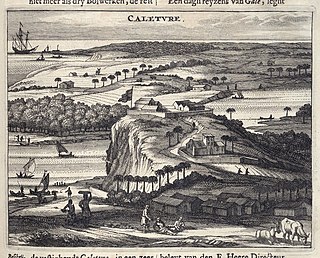
Jaffna Fort is a fort built by the Portuguese at Jaffna, Sri Lanka in 1618 under Phillippe de Oliveira following the Portuguese invasion of Jaffna. The fort is located near Karaiyur. Due to numerous miracles attributed to the statue of Virgin Mary in the church nearby, the fort was named as Fortress of Our Lady of Miracles of Jafanapatão. It was captured by the Dutch under Rijcklof van Goens in 1658 who expanded it. In 1795, it was taken over by the British, and remained under the control of a British garrison till 1948. As the only large military fort in the country, due to the presence of only government and military buildings within its ramparts, it was garrisoned by a detachment of the Ceylon Army.

The Batticaloa Fort was built by the Portuguese in 1628 and was captured by the Dutch on 18 May 1638. From 1745, the fort was used by the British.

The Kayts Island Fort was built by the Portuguese in 1629 and was abandoned in 1651. In the late 1600s, Dutch controlled the fort when they took over the Kayts island. During the Dutch rule, it was not normal to undergo restoration like the former forts of Portugal.

Arippu Fort was built by the Portuguese and was handed over to the Dutch in 1658. The small bastion fort is located in Arippu, which is 16 km (9.9 mi) away from Mannar Island. The fort is nearly square in shape, with two bastions.

Elephant Pass Fort was a small fort in the strategically important spot as it linked Jaffna peninsula to the mainland. It was built by the Dutch in 1776 on the banks of the Jaffna lagoon.

Kalpitiya Fort was built by the Dutch between 1667 and 1676. Kalpitiya was important as it commands the entrance to the adjacent bay, Puttalam Lagoon. The surrounding Puttalam area was one of the major cinnamon cultivation areas in Sri Lanka. The Dutch even constructed a canal from Puttalam via Negombo to Colombo to transport cinnamon from the area.

Fort Beschutter or Fort Pass Beschutter was a small fort, which was linearly located between Elephant Pass Fort and Fort Pass Pyl in the narrow part of the Jaffna peninsula. The strategic fort was used to protect Jaffna peninsula from the forces of mainland as well as illegal access, smuggling, etc.

Fort Pyl or Fort Pass Pyl was a small fort in the Elephant Pass Fort areas, which is narrow part of the Jaffna peninsula. The fort was located in line with two other forts, Elephant Pass fort and Fort Beschutter, in order to protect Jaffna peninsula from attacks originating from the mainland.

Mannar Fort is located on Mannar Island, Sri Lanka. It was built by Portuguese in 1560. The fort fell to the Dutch in 1658, and they rebuilt the fort in 1696. In 1795 the British occupied the fort following the surrender by the Dutch.

Pooneryn Fort is located in Pooneryn, adjacent to the Jaffna Peninsula. It was built by Portuguese to protect their possessions in Jaffna. The fort was captured by the Dutch in 1658, and subsequently by the British in 1796.

Tangalle Fort is a small Dutch fort located in the coastal town of Tangalle, Sri Lanka. The Dutch used Tangalle as an important anchorage on the southern coast of the island.

Ratnapura Portuguese fort was built by the Portuguese in Ratnapura, Sri Lanka.

Kalutara fort was built by the Portuguese in 1622. It was located in Kalutara, Sri Lanka.

Katuwana Fort, is an inland fort constructed by the Dutch in 1646.

Koddiyar fort was the first fort that was built by Dutch in Ceylon. It was constructed in 1622 and is located on the southern side of Koddiyar Bay.

Arandora Fort was built by the Portuguese in Narangoda, Kurunegala, and was captured by Dutch in 1665.

Ruwanwella fort, was initially a fortified base camp erected by the Portuguese in 1590s at Ruwanwella, Kegalle. It was captured by Dutch in 1665, who constructed a wooden fort (Ruanelle) but abandoned it within a few years. In 1817 the British built a stone fort on the site with two bastions.

Menikkadawara fort, was a small fort located at Menikkadawara, Kegalle. The Portuguese called the place, Manicravaré or Manicavarê.

Hanwella fort was located in Hanwella, Colombo, on the banks of the Kelani River. Hanwella, which means 'skin sands', was the site of an ancient ferry route across the river. Malwana fort was situated about 15 km (9.3 mi) on the other side of the Kelani River.

Sitawaka fort, was built by the Sitawaka kingdom in Avissawella, Sri Lanka. It was adjoined with the palace of king Rajasinha I. The fort had been mounted with cannon on the river bank.













